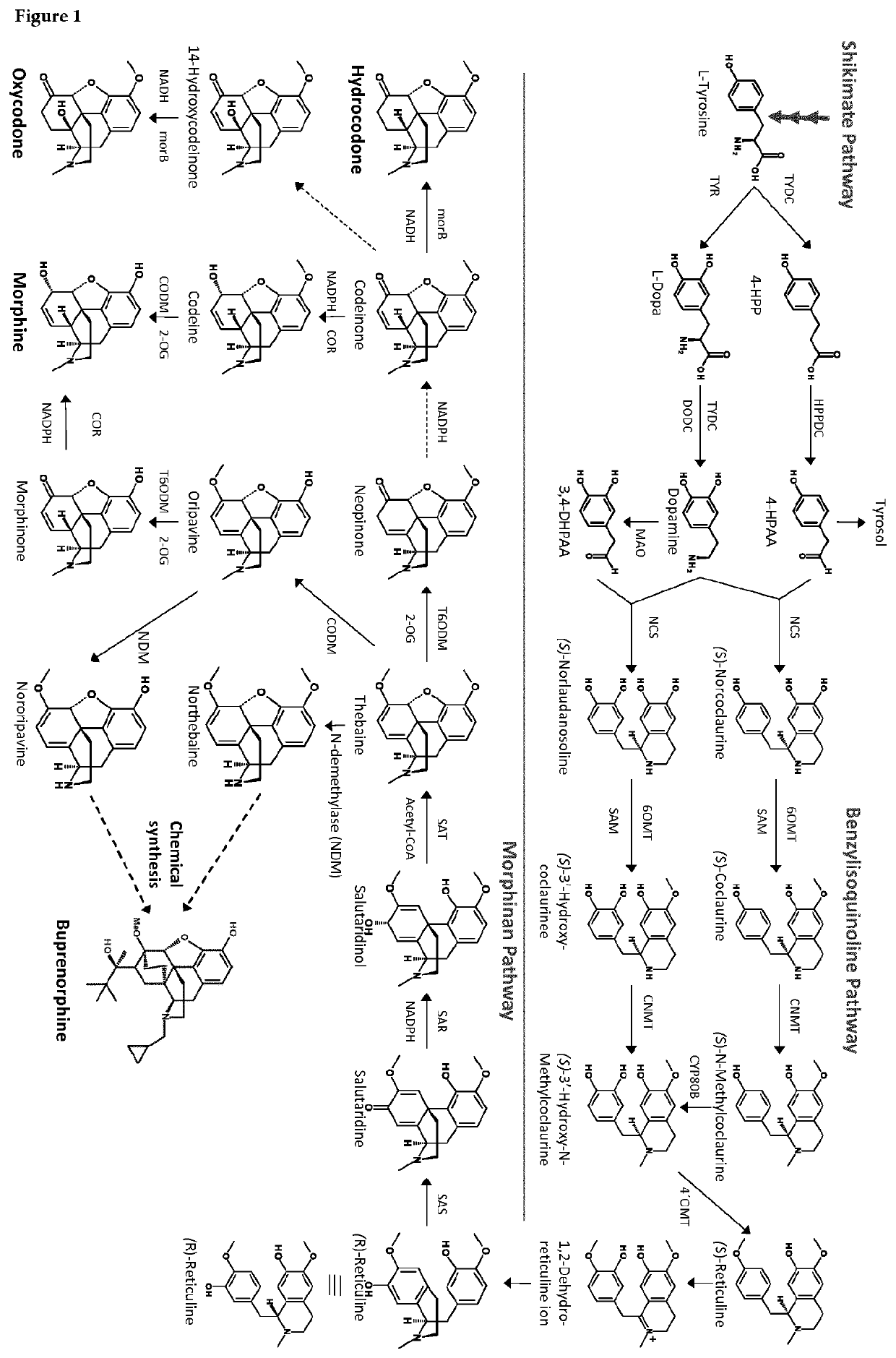Microbial cell with improved in vivo conversion of thebaine/oripavine
a microbial cell and in vivo conversion technology, applied in the field of recombinant microbial host cells, can solve the problems of insufficient overall yield of opioids from engineered microbial-based (e.g. yeast-based) manufacturing process of opioids in the art, instability and variability in the supply chain, and achieve the effect of positive in vivo conversion effect, and increasing the amount of thebain
- Summary
- Abstract
- Description
- Claims
- Application Information
AI Technical Summary
Benefits of technology
Problems solved by technology
Method used
Image
Examples
example 1
gineering
[0466]Saccharomyces cerevisiae yeast strains were constructed in strain background EVST25898 (genotype MATalpha his3Δ0 leu2Δ0 ura3Δ0 aro3Δ::pTEF1-ARO4(K229L)-tCYC1::pPGK1-ARO7(T266L)tADH1::KI CAT5-91Met GAL2 ho MIP1-661Thr SAL1-1 YORWΔ22::npBIO1nt20npBIO6nt).
[0467]The EVST25898 with the genotype above corresponds to S288C (genotype MATalpha his3Δ0 leu2Δ0 ura3Δ0). S288C is a publicly available widely used laboratory strain (see the Saccharomyces Genome Database (SGD)). As is known from other works, one would get similar results by use of EVST25898 with genotype above or by use of S288C (genotype MATalpha his3Δ0 leu2Δ0 ura3Δ0) as background / control strains, since these two host phenotypes are substantially identical.
[0468]Strain was transformed with relevant plasmids using the lithium acetate method (Gietz et al. 2002. Methods Enzymol. Vol 350, p 87-96).
[0469]For testing the impact of possible transporter proteins on the bioconversion of Thebaine ...
example 2
on and Harvest of Yeast Strains
[0473]Cultivation. Yeast strains were cultivated in 96-deep-well-plate (DWP) format. Cells were grown in 0.5 ml SC-His-Leu-Ura medium at 30° C. with shaking at 250 rpm in ISF1-X Kuhner shaker for 20-24 hours and utilized as precultures for in vivo bioconversion assays.
[0474]50 μl of the overnight cell cultures were grown in 450 μl Synthetic complete (SC)-His-Leu-Ura medium (pH 7) or DELFT minimal medium (pH 7) containing 0.5 mM thebaine or oripavine. Both media contain 0.1 M potassium phosphate buffer.
[0475]Thebaine (or Oripavine) were added via a 25 mM stock solution in DMSO. Cells were grown for 72 hours with shaking at 250 rpm.
[0476]Harvest. 50 μl of cell cultures were transferred to a new 96-deep-well-plate containing 50 μl of MilliQ water. The harvested 96 well plate was incubated at 80° C. for 10 minutes. Plate was then centrifugated for 10 minutes at 4000 rpm. The supernatants were then diluted in MilliQ water to reach a final dilution of 1:100....
example 3
cedures
[0477]For all compounds (Thebaine, Northebaine, Oripavine and Nororipavine) stock solutions were prepared in DMSO at a concentration of 10 mM. Standard solutions were prepared at concentrations of 6 μM, 4 μM, 2 μM, 1 μM, 500 μM, 200 nM, 100 nM, 50 nM, 20 nM and 10 nM from the stock solutions. Samples were injected into the Agilent 1290 UPLC coupled to an Ultivo Triple Quadrupole. The LC-MS method was as follows: Mobile Phase A. H2O+0.1% Formic acid; Mobile Phase B: Acetonitrile+0.1% Formic acid; Column: Phenornenex Kinetex 1.7 μm XB-C18 100 Å, 2.1×100 mm. The elution gradient is shown hi Table 2 and the LC-MS conditions are given in Table 3. Table 4 shows the mass spectrometer source and detector parameters and Table 5 shows the target compounds, their retention times, their parent on, transition ions (MRM) as well as dwell times, cone voltages and collision energies used.
TABLE 2Gradient for LC-MSTime (min)% B020.3024.00304.401004.901005262
TABLE 3LC-MS conditionsParameterValu...
PUM
| Property | Measurement | Unit |
|---|---|---|
| size | aaaaa | aaaaa |
| concentration | aaaaa | aaaaa |
| width | aaaaa | aaaaa |
Abstract
Description
Claims
Application Information
 Login to View More
Login to View More - R&D
- Intellectual Property
- Life Sciences
- Materials
- Tech Scout
- Unparalleled Data Quality
- Higher Quality Content
- 60% Fewer Hallucinations
Browse by: Latest US Patents, China's latest patents, Technical Efficacy Thesaurus, Application Domain, Technology Topic, Popular Technical Reports.
© 2025 PatSnap. All rights reserved.Legal|Privacy policy|Modern Slavery Act Transparency Statement|Sitemap|About US| Contact US: help@patsnap.com

